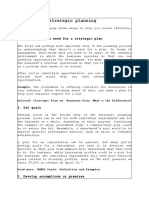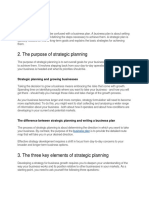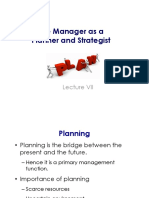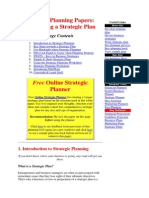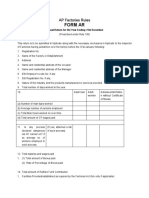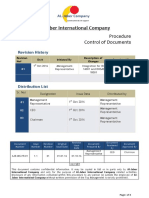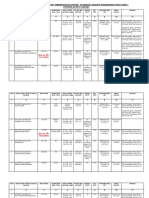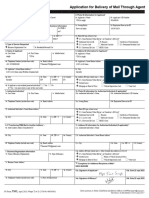CHAPTER FIVE
PLANNING FOR EVENT AND EVENT PROPOSAL
5.1. Event Planning
What is best definition of planning?
Planning is deciding in advance what to do, how to do it, when to do it, and who should do it.
This bridges the gap from where the organization is to where it wants to be. The planning
function involves establishing goals and arranging them in logical order.
The first and foremost thing to do while planning an event is to know about the client’s
expectations. When a client first approaches you for assigning a task, sit with him and find out
what he wants and how he wants it. Keep in mind the fact that the client has a very hazy idea of
what he wants. He expects you to change that hazy idea into a reality. So, you first need to strike
a good rapport with him. Once you know his expectations you can start giving your inputs. Since
you are a professional event planner he is bound to believe that you have a better knowledge
about these things and will respect your judgment.
The six-stage event-planning process consists of the following steps:
1. Define goals and the target market
2. Research critical success factors (CSFs)
3. Determine the skills and resources required
4. Link the skills and resources to the CSFs
5. Develop strategies
6. Finalize plans.
A) Define goals and the target market
The first step in the planning process is to define the organization’s goals and objectives, and to
set priorities. This step will be built on the vision (the reason for being of the operation), and can
be presented as a mission statement. A series of questions is suggested below to aid planners in
asking pertinent questions and in thinking strategic-ally about the business and where it wants to
be in the future:
What sort of company are you?
Where do you want to be in a few years’ time?
What are your main targets?
Who or what is the main market?
1|Page
� What is your main style of event?
What do your customers value?
It may take some time before the answers to these questions can be answered honestly and
clearly. The answers, and the analysis which preceded them, will assist in this first step.
B) Research critical success factors (CSFs)
The second step occurs when, having decided on your main market, your main customers and
your main style of events, you need to ascertain what it is your customers want.
Questions include:
● What are the critical success factors that your customers demand?
● What will make you better than the competition?
● What opportunities exist?
C) Determine the skills and resources required
The third step is to determine the competencies, skills and resources required to deliver your
customers’ needs. You would do this by critically auditing your internal strengths and
weaknesses. It is concerned with how these linkages in an organization and relationships can be
strengthened in order to add strength to your organization. This is about the creation of synergy.
D) Link the skills and resources to the CSFs
The fourth step is to link competences and resources to external forces and situations. This is
done by reviewing external influences under the headings of political factors, economic factors,
technology, and competition, and by carrying out an internal audit. The results of these analyses
should form part of the summary of the organization’s SWOT (strengths, weaknesses,
opportunities and threats) analysis. Opportunities and threats are external to the business, and
strengths and weakness are internal aspects. Examples of strengths might be financial stability,
good networking opportunities, and a good client base and reputation; weaknesses might be lack
of skilled staff and a poor cash flow. An opportunity might be an emerging new market, and a
threat will surely be new and emerging competition.
It is not sufficient merely to list strengths, weaknesses, opportunities and threats. The real
purpose is to determine what actions have to be taken to capitalize on the strengths, eliminate the
weaknesses, and counter threats to exploit opportunities. Often a threat, if considered in a
positive manner, can be turned into an opportunity.
2|Page
� E) Develop strategy
The fifth step is to develop strategies to enable achievement of the business objectives. In simple
terms, objectives/goals are what we want to do, and strategies are how we will do it – i.e. the
necessary actions required to make the objectives happen.
F) Finalize plans
The sixth step is when the strategy is finalized, and action plans can then be made. These
concern the specific details about the event – for example, how many people are coming, over
what time period, and how much space is required?
5.2. Strategic Event Planning
Strategic event planning is about data and analytics. It’s about creating goals that will tell you if
your event served the purpose it was meant to serve or if it flopped. You need to understand the
data you can gather at your events and whether
Seven steps of a strategic planning process
Consider the following seven steps to help you create effective, actionable plans:
i. Understand the need for a strategic plan.
ii. Set goals.
iii. Develop assumptions or premises.
iv. Research different ways to achieve objectives.
v. Choose your plan of action.
vi. Develop a supporting plan.
vii. Implement the strategic plan.
1. Understand the need for a strategic plan
The first and perhaps most important step of the planning process is understanding that there is a
need for a plan. In terms of management, this means that you need to be aware of the industry
environment in which the business operates so that you can identify opportunities for
development. You must also be aware of the business’s internal operations so that you will know
when there is a problem that needs to be solved.
After you have identified opportunities, you can begin looking at actions that would help you
take advantage of those opportunities. For example, perhaps the government is offering contracts
3|Page
�for businesses in your industry. If you are aware of this, you can make a plan to help your
business compete for a bid.
2. Set goals
Setting goals is the second step of the strategic planning process. Goals can be set for both
individual departments and for the business as a whole, depending on their purpose. Continuing
the example of using government bids, a company-wide goal could be to secure the bid.
Meanwhile, a department goal would be to improve specific performance metrics, such as sales
or customer satisfaction.
A goal for an organization can be general, but when you are setting goals for a department, you
need to be detailed and specific so that your team members will understand what they need to do.
For instance, while increasing profits could be a goal for the business, the individual departments
will need more detailed goals related to boosting profits, such as “We will generate an extra
$5,000 in revenue by April 24.”
Goals are vital to the strategic planning process because they allow managers to more effectively
direct their teams. They give employees a common purpose to work toward so that their daily
activities will be more focused.
3. Develop assumptions or premises
When you make a plan for your business, it should be done with the future in mind. Of course,
the future is unpredictable, which means your plan will need to be based on certain assumptions
or premises. A forecast is a common type of premise that involves making certain predictions
about the future. If the company’s goal is to increase profits, management would need to forecast
whether or not that the industry would be able to support an increase in profits.
During the strategic planning process, you will need to develop both internal and external
premises. Internal premises are based on the inner workings of the company and factors. Some
examples of internal premises include:
The resources you expect to have available
Company policies that you need or will have to implement
How the levels of management will interact with the plan
External premises are anything outside of the company that may affect the plan and the ability to
achieve set objectives. Some examples of external premises include:
4|Page
� o The political and social environment
o Technological advancements
o Competition from other businesses
When trying to achieve an organizational goal, it is important that all managers are operating
under the same premises and that they agree with the premises.
4. Research different ways to achieve objectives
There are usually several different ways to achieve a goal. You will need to take the time to
research various ways your team could work toward completing a set objective. Researching
different solutions for completing a goal is important because it gives managers some flexibility
when they are directing their teams. Some managers may prefer innovative solutions for
completing goals, while others may wish to use more traditional methods.
When researching different ways to achieve objectives, the goal should be to narrow options
down to a few choices. As we mentioned, there are likely countless solutions for achieving the
goals that have been set, and if you do not narrow down the options, it will be hard for your
managers to choose a solution that works.
Once you have identified a few of the best ways to potentially achieve your goals, it is time to
closely examine these solutions to decide which the best option. You need to carefully consider
the strengths and weaknesses of each solution, particularly as they relate to your business’s set
goals. Imagine that you are developing a financial plan for your company. For every possible
plan, you would need to evaluate the risks of the plans as well as the potential returns. You
would also need to analyze each option you consider to see if it would help you efficiently
achieve your final objective.
5. Choose your plan of action
Once you have set your objectives, developed your premises and identified or evaluated different
solutions for completing your goals, you can then decide which course of action to take. Ideally,
the strategic plan that you choose is the one that will be the most profitable. Before you choose
your plan of action, there are a few things you will need to keep in mind:
Avoid a plan that could potentially cost the business money. This is something to consider
whether it’s in the short term or the long term. Be sure that you select the plan that has the least
amount of potentially negative consequences. Every plan you can choose will naturally have
5|Page
�drawbacks, but some plans will have more disadvantages than others. Compare the different
options for completing your goal, and choose the one that has the highest chance of success.
Choose a plan of action that is adaptable. While you are executing your plan, you may encounter
obstacles that you did not anticipate. If your plan is flexible, you should be able to overcome
these obstacles more easily than with a plan that’s fixed. For example, if the business is pursuing
a government bid and the government institutes a new policy, you may need to alter your bid so
that you can comply with the new policy.
When you form a plan of action, you should largely base your decision on concrete evidence,
such as mathematical analysis. That said, your experience as a manager can also help you decide
which plan is best for accomplishing your set objectives. Drawing on your personal history, you
may realize one of the plans being considered is something you have seen implemented in the
past and that you know to be effective.
You can also take elements of various strategic plans and use them together. For example, if you
are comparing two financial plans, perhaps one has a better solution for increasing profits and the
other contains an effective strategy for shielding the business from unexpected losses. You could
combine these two elements to create one strong plan.
6. Develop a supporting plan
Once you know which plan you are going to implement, you may also need to develop a
secondary plan to help you institute the primary plan. Secondary plans will vary depending on
your objectives, so you should keep your goals in mind while developing this additional plan.
If your objective is for your company to launch a new product your main plan may include steps,
such as product research, developing a marketing plan and arranging for manufacturing. The
secondary plan will include all the steps that you need to take to support the implementation of
the main plan.
For example, you might need to expand your product research team, which means hiring new
employees could be a step in your secondary plan. Similarly, you may need to hire a product
research team if your firm does not already have one or increase your company’s manufacturing
capability if your current facilities are not suitable for the new product. Training personnel is a
common component of a secondary plan regardless of the goal. Whether you are trying to launch
6|Page
�a new product or want to increase sales of a current product, your staff will likely need further
training before the company will be able to achieve these objectives.
7. Implement the strategic plan
The final step of the strategic planning process is implementing the plan. In some cases, this can
be the most involved step in the planning process depending on the objectives you have set.
When it comes time to implement a plan, managers draw on their skill set and experiences to
make sure everything runs smoothly.
If the organizational goal is particularly complex, managers will need to take the time necessary
to make sure their team members understand their responsibilities and how everyone connects to
the larger goal. All team members need to be informed and work together to make the project
successful.
The tools you will need to implement the plan depend on the specific circumstances. For
instance, if your plan is related to instituting a new company policy, implementation of the plan
will require consulting with the legal department to make sure that the policy is outlined
correctly so that it will be effective.
5.4. Role of Event Planner: Event Planner duties and responsibilities
The duties and responsibilities of an Event Planner require the ability to communicate well with
customers and venues. Event planners must pay careful attention to detail using information from
several sources to plan a successful event. Other Event Planner responsibilities include:
Listening attentively to customer requests and keeping records of these requests
Managing and budgeting customer finances
Selecting an appropriate venue suitable for the type of event
Having good knowledge of geographic locations and their main attractions
Organizing audio-visual equipment in advance
Coordinating hotels, transportation and food
Attending and monitoring activities to ensure client satisfaction
Reviewing bills and approving payments
What does an Event Planner do?
Event Planners typically work for corporations, venues, event planning companies or hotels and
resorts. They can also be self-employed individuals. They use their eye for design and
7|Page
�management skills to oversee an event from the planning and preparation phase through to
completion. Their job is to work with one or more clients at a time to help them establish their
event needs within a particular budget. They use this information to book venues and hire
entertainment, Caterers and Designers. They may also undertake the job of creating and sending
out invitations to the client’s desired guest list.
5.5. Preparation for Event Proposal: How to Write an Event Proposal
Because planning an event requires customizing that event to suit your client’s needs and budget,
your proposal should reflect an event that is personal and unique.
A Note before You Start
The first step is to meet with your prospective client to discuss what they have in mind for this
event, what the purpose is, the number of guests, and what they hope to accomplish. In addition
to date, time, and desired location, notes any ideas regarding the theme, catering, overall
aesthetics, colors, or ambiance discussed during this meeting.
Getting Started on the Event Proposal
Each proposal should be written with the client in mind. Event planning is a service business,
and that service, personal touch, and creative approach are what make an event successful and
memorable, two characteristics that go a long way in generating new customers for your
business. Proposals should be well written and thoroughly researched, providing the necessary
details so that the client can envision what you have in mind.
1. Introduce yourself and the project
Begin with a brief introduction to you and your event planning business. Include specifics such
as how long you have been in business and your professional background. Some planners put
this section at the end, much like a book author's biography on a dust jacket or back cover.
2. Write an attractive event description
Summarize the actual event, including the details discussed during your meetings, such as the
goal of the event, general time frame, number of guests, and possible venues. If you are not a
skilled writer, find or hire someone skilled with words to give this section as much appeal as
possible.
3. List all services provided
8|Page
�This section is particularly important. The client needs to know specifically what services you
will provide for this event. A checklist with bullet points clearly shows the different services that
are included. This approach works well for smaller functions such as bridal showers or
celebratory dinners and is easy for the client to see what you will do and any vendors you will
use. For larger events with multiple functions, such as a cocktail hour or luncheon, you may want
to create sections for each aspect of the event and then list the specific services provided for each
one.
4. Show your previous work
If you have planned similar events in the past, include photos of these events to showcase your
work. Visual representations can help the client see what you can do, and are a great assurance to
you that your style matches their vision. Having things to compare against can really help
streamline the event once it comes time to break ground.
5. Incorporate monetary information throughout
While the client may be reading your proposal and taking in all the details and images of the
event you envision, this mind-set usually shifts gears when it comes to the section that talks
about money. You don't want the process coming to an abrupt stop, so avoid sudden changes in
the language or tone to all business and facts. Title a section “Proposed Costs” and continue to
guide the client through the aspects of this event by carefully articulating the costs, while
peppering prices throughout the proposal. Help your client see your proposal as a series of steps,
each with different services and related costs. Provide a detailed summary that lists the price for
each item and its purpose so that the client can envision the event and understand the related
cost.
A Final Word
The last piece of your proposal is a thank-you for their consideration. Provide contact
information-including your website, email address, and phone number—so that prospective
clients can get in touch with you with any questions or, even better, to hire you for the job.
5.6. Corporate Event Planning Ideas and Tips
Any business that wants to build lasting relationships needs to know how to produce
professional events. Whether you're hosting a product launch for 300 people or an employee
training for 15, it's key to approach each gathering with an understanding of the five elements of
9|Page
�event management – research, design, planning, coordination and evaluation. Once an event is
broken up into these manageable stages, it is much easier to conceptualize it and pull together the
many moving pieces needed to bring it to life.
“Events provide businesses a personal way to build relationships with their target audiences [as
well as] build brand recognition and loyalty," said Myke Nahorniak.
Here are 10 tips on how to plan an event that your attendees won't soon forget.
1. Understand the purpose of your event
Once you decide you want to host an event, your first step is to define what you hope to
accomplish. "It is important to know the goals and objectives of the event you are trying to
produce before you can do anything else,"
Start by asking yourself why you are hosting the event and what you expect from it. Once you've
identified your goals and expectations, you can then determine what kind of event will resonate
with your intended audience.
"Rather than thinking of it as just a corporate event, think about it like you're delivering an
interactive brand experience," said Serena Holmes.
2. Set a realistic budget.
You need to know how much money you have to work with to determine what sort of event you
can produce. "Things are always changing, and you should have a cushion for added and
unexpected expenses that pop up," he said. Once you have a budget, knowing where to allocate
most of your resources is essential. For example, if you spend more money on fancy decorations
than you do on a skilled tech crew or personable speakers, your event might be lacking in
substance.
3. Establish a project timeline.
Designing the event requires you to keep track of a broad range of tasks. This can be facilitated
by creating a master detailed checklist. There are new, tech-savvy tools that streamline and
simplify the managing of dozens, if not hundreds, of tiny details.
10 | P a g e
�The overall planning checklist serves as a tool for the duration of the planning process," said
Valerie Gernhauser, owner and principal planner of Sapphire Events. Gernhauser said her team
starts with a list for 12 months out and works in checklist increments at nine months, six months,
four months, two months, the month of, two weeks out, the week of and the day of the event.
"Breaking down the task list like this helps our team foresee the schedule of milestones we need
to target," she said. To keep your checklist on track, , recommends creating a spreadsheet and
using individual tabs for each event category, such as venue, speakers, schedule, agenda and
travel. This way, you can list each activity or task, the people responsible for each part of the
process
4. Decide on your audience.
An important part of the planning process is defining your target audience. Is it your company's
executives, managers, long-time clients, business partners, community members, or a
combination of a few of these or other groups? Once you can name your audience, you can cater
the program to their needs and interests, and all the relevant deadlines.
5. Choose a theme and format.
Once you have set your objectives and defined the audience, it's time to choose a theme or topic
for the event and determine the best format for presenting it to your guests.
For example, coordinating a client event with an industry expert, such as a guest speaker, can
position your company as a trusted advisor instead of just a vendor.
6. Select an appropriate location.
Once you decide the type of event you'd like to create, it's time to find a venue that allows you to
bring your vision to life. According to Barnes, "location is key to attendance." She recommends
booking a venue in a convenient area with a vibrant atmosphere so attendees feel comfortable
and willing to make the commute.
7. Plan the logistics of the day.
To have a successful event, you will have to identify, vet and contract all the necessary event
specialists. This may include caterers, audio-visual technicians, printers, decorators,
photographers, florists and security personnel, to name just a few. Of course, you must also book
11 | P a g e
�speakers and presenters, including prominent figures, experts or influencers, who can best
communicate the ideas you'd like to circulate throughout the gathering.
To assure everything goes according to your plan, determine a timeline for the event, and make
sure everyone on your team knows what aspects of the day they are responsible for managing.
8. Promote your event.
If people don't know about your event, no one will show up, so it's imperative to find creative
ways to get the word out. For a small event with a limited guest list, you can simply send out
invitations, but you need to be bolder for larger events. From there, you can promote on social
media and have your team spread the word. Create an event website or, at a minimum, a new
landing page on your current site. Your social media marketing can also include promo videos,
guest blog posts, and Facebook, Instagram or Twitter updates. Maintain uniformity by using the
same handle and hashtag across platforms and consistent messaging so it's always clear that the
buzz is about one particular event.
9. Make use of technology
Today, there are tons of event management software platforms and apps (some of which offer a
free base product) that do everything from providing seamless onsite check-in of attendees to
enhancing the appeal of workshops and presentations with simulations and virtual reality games.
Event management software keeps your project on track, but it also makes it easier to work
collaboratively with vendors and other creative partners.
10. Celebrate and evaluate your event planning success.
Most importantly, you want to gather feedback from guests. If you used an event-planning app
with a feedback option, you can use it to ask attendees questions. This information will help you
determine if the event met your original goals and what impact, if any, it had on the attendees.
You can then share this information with all the relevant stakeholders so an appropriate follow-
up can be planned. The lessons you learn will help you refine your planning for the next event.
5.7. Conference Planning
Conferences are an important part of professional development and business networking for all
industries. Bringing people together from all around the world in the same industry to learn and
share is essential for innovation.
12 | P a g e









